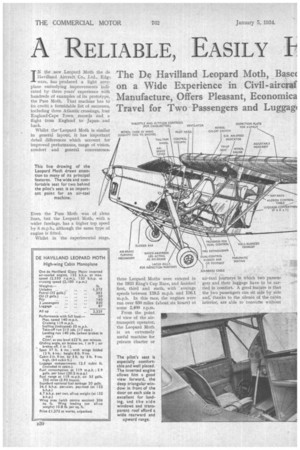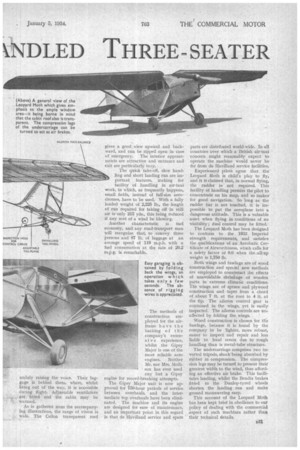A RELIABLE, EASILY I
Page 44

Page 45

If you've noticed an error in this article please click here to report it so we can fix it.
kNDLED TI-I
EESEATER
The De Havilland Leopard Moth, Basec on a Wide Experience in Civil-aircraf Manufacture, Offers Pleasant, Economica Travel for Two Passengers and Luggagl
IN the new Leopard Moth the de Havillancl Aircraft Co., Ltd.,. Edg7 ware, has produced a light aeroplane embodying improvements indicated by three years' experience with hundreds of examples of its prototype, the Puss Moth. That machine has to its credit a formidable list of successes, including three Atlantic crossings, four England-Cape Town records and a flight from England to Japanand back.
Whilst the Leopard Moth is similar in general layout, it has important detail differences which account for improved performance, range of vision, comfort and general convenience.
Even the Puss Moth was of clean lines, but the Leopard Moth, with a wider fuselage, has a higher top speed by 8 m.p.h., although the same type of engine is fitted.
Whilst in the experimental stage,
three Leopard Moths were entered in the 1933 King's Cup Race, and finished first, third and sixth, with average speeds between 139.5 m.p.h. and 136.1 m.p.h. In this race, the engines were run over 830 miles (about six hours) at some 2,400 r.p.m.
From the point of view of the airtransport operator, the Leopard Moth is an extremely useful machine for private charter or air-taxi journeys in which two passengers and their luggage have to be carried in comfort. A good feature is that the two passengers can sit side by side and; thanks to the silenee of the cabin interior, are able to converse without
unduly raising the voice. Their luggage is behind them, where, whilst being out of the way, it is accessible during flight. Adjustable ventilators are fitted and the cabin may be warmed.
As is gatherea irom the accompanying illustrations, the range of vision is wide. The Cellon transparent roof
gives a good view upward and backward, and can be ripped open in case of emergency. The interior appointments are attractive and entrance and exit are particUlarly easy.
The quick take-off, slow handling and short landing run are important features, making for iacility of handling in air-taxi work, in which, as frequently happens, small fields, instead of full-size aerodromes, have to be used. With a fully loaded weight of 2,225 lb., the -length of run •required for taking off in still air is only 215 yds., this being reduced if any sort of a wind be blowirg.
Another characteristic is iuel economy, and any road-transport man will recognize that, to convey three persons and 87 lb. of luggage at an average speed of 119 m.p.h. with a fuel consumption at the rate of 20.2 is remarkable.
The methods of construction employed for the airframe have the backing of the company's extensive experience, whilst the Gipsy Major is one of the most reliable aero engines. Neither Mr. nor Mrs. Mornson has ever used any but a Gipsy engine for record-breaking attempts.
The Gipsy Major unit is now approved for 750-hour periods of service between overhauls, and the intermediate top overhauls have been eliminated. The machine and its engine are designed for ease of maintenance, and an important point in this regard is that de Havilland service and spare
parts are distributed world-wide. In all countries over which a British air-taxi concern might reasonably expect to operate the machine would never be far from de Havilland service facilities.
Experienced pilot's agree that the Leopard Moth is child's play to fly, and it is claimed that, in normal flying, the rudder is not required. This facility of handling permits the pilot to concentrate on his map, and so makes for good navigation. So long as the rudder bar is not touched, it is impossible to put the aeroplane into a dangerous attitude. This is a valuable 'asset when flying in conditions of no visibility ; dual control may be fitted.
The Leopard Moth has been designed to conform to the 1933 Imperial strength requirements, and satisfies the qualifications of an Aerobatic Certificate of Airworthiness, which calls for a safety factor of 9.0 when the.alkup weight is 1,750 lb.
Both wings and fuselage are of wood construction and special new methods are employed to counteract the effects of unavoidable shrinkage of wooden parts in extreme climatic conditions. The wings are of spruce and plywood construction and taper from a chord of about 7 ft. at the root to 4 ft. at the tip. The aileron control gear is contained in the wings, yet is easily inspected. The aileron controls are un
affected by folding the wings. '
Wood construction is chosen for th'e fuselage, because it is found by the company to be lighter, more robust, easier to inspect and repair and less liable to local strain due to rough handling than is metal-tube structure.
The undercarriage comprises two inverted tripods, shock being absorbed by rubber in compression. The compression legs may be turned to present their greatest width to th.e wind, thus affording an effective air brake. This facilitates landing, whilst the Bendix brakes fitted to the Dunlop-tyred wheels shorten the landing run and make ground manceuvring easy. This account of the Leopard Moth has been kept brief in obedience to our policy of dealing with the commercial aspect of such machines rather than their technical details.




























































































